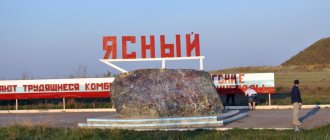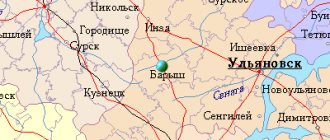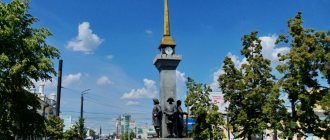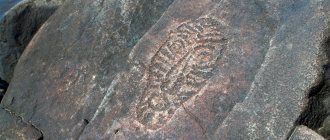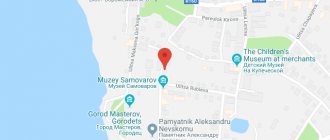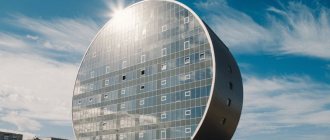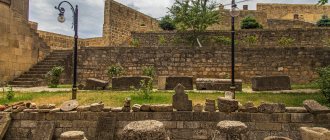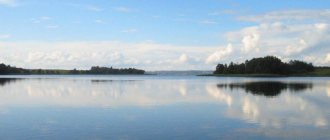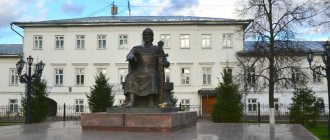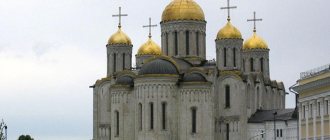Marks is a city in the Saratov region, a regional center. It is located on the left bank of the Volga, 60 km from the regional center.
It is connected with Saratov and nearby cities by a developed bus network. There is no railway in this part of the Volga region, there is a cargo port on the river, and there is no passenger water service.
About the city of Marks
Marx was founded as a German colony and the exact date of its creation still raises questions among historians. The official date is August 27, 1766, but there are versions about 1764 and 65.
A new German colony was created by the Belgian baron Frederic Beauregard de Cano, who invited compatriots to the fertile Saratov lands. The colony became baronial, then German settlements were divided into provocative ones, where residents paid taxes in favor of these entrepreneurs, and crown ones.
The baron's residence was created here. The colony received the name in honor of the Empress, Catherinenstadt.
In total, during the period of active attraction of immigrants from Europe, 106 colonies were created, where 6,174 families lived, or 23,404. The future Marx was built on the left bank of the Volga, then called the Meadow Side.
The colony became the largest of the newly created ones; military engineer Ivan Rice is considered its founder. He was engaged in both cartography of the area and the construction of the settlement. The problem for the new point on the map was the constant attacks of nomads who captured men and took them to China.
There is a known correspondence between the headman of Ekaterinenstadt and the empress, in which he asked to reduce fees, since most of the payers were captured.
Gradually the colony grew stronger, surrounded its borders with walls, and then the raids stopped. Accelerated economic development began. Actively received and transshipped cargo, mainly bread, pier.
Warehouses, barns, and mills appeared. American cigar tobacco became a serious factor in Ekaterinenstadt's trade balance; the district quickly became the center for the cultivation of this crop in the Volga region, confidently occupying second place in its production in the Russian Empire.
In addition to tobacco, such an unusual spicy crop as anise was grown in the area. There was a leather tanning factory.
Education developed; in 1832, the Russian Central School was opened here, the first among all German colonies in Russia. In 1848-51, a monument to Catherine the Second was unveiled, funds for which were collected by the entire village.
It was surrounded by a garden. We collected more than 14 thousand silver rubles. The monument was destroyed after the revolution. During the period of active development, at the end of the 19th century, workshops for the production of agricultural machinery were built here.
Map
| Marx: cards |
Marx: photo from space (Google Maps) Marx: photo from space (Microsoft Virtual Earth)
| Marx. Nearest cities. Distances in km. on the map (in brackets along roads) + direction. Using the hyperlink in the distance , you can get the route (information courtesy of the AutoTransInfo website) | |||
| 1 | Voskresenskoye | 18 (184) | NE |
| 2 | Stepnoe | 36 () | YU |
| 3 | Engels | 48 (54) | SW |
| 4 | Saratov | 52 (69) | Z |
| 5 | Hay | 53 (178) | WITH |
| 6 | Shihany | 55 (161) | NE |
| 7 | Privolzhsky | 57 (67) | SW |
| 8 | Volsk | 58 (142) | NE |
| 9 | Sokolovy | 64 (79) | Z |
| 10 | New Burasy | 67 (128) | NW |
| 11 | Bazarny Karabulak | 67 (167) | WITH |
| 12 | Mokrous | 73 (125) | SE |
| 13 | Free | 74 () | WITH |
| 14 | Light | 77 (105) | Z |
| 15 | Tatishchevo | 79 (101) | Z |
| 16 | Balakovo | 81 (108) | NE |
| 17 | Red Kut | 84 (132) | YU |
| 18 | Baltai | 85 (200) | WITH |
| 19 | Krasnoarmeysk | 105 (151) | SW |
| 20 | Ershov | 112 (188) | IN |
| 21 | Pavlovka (Ulyanovsk region) | 112 (225) | WITH |
| 22 | Rivne | 113 (155) | SW |
| 23 | Petrovsk | 115 (165) | NW |
| 24 | Lopatino (Penza region) | 120 (214) | NW |
| 25 | Neverkino (Penza region) | 120 (293) | WITH |
a brief description of
Located on the left bank of the Volga (Volgograd Reservoir), 50 km from the railway. Pokrovsk station, 60 km northeast of Saratov.
Territory (sq. km): 14
Information about the city of Marx on the Russian Wikipedia site
Historical sketch
It was founded in 1767 as a German colony by the Dutch Baron Cano de Beauregard and received the name Baronsk after his title. Soon it was renamed in honor of the Russian Empress Catherine II Alekseevna (1729-96) to Ekaterinenstadt - “Catherine’s city” (German Stadt “city”).
The city since 1918. In 1920 it was renamed Marxstadt, after the name of the communist theorist Karl Marx (1818-83). In 1941, during a campaign to eliminate German names, the German element of the Stadt was removed and the city became known as Marx.
Economy
PA: Volgodieselmash (former), Tantal. , brewery, butter and cheese making and other enterprises.
Marks is the center of an agricultural area.
Main enterprises
MECHANICAL ENGINEERING
OJSC "Volgodieselapparat"
413060, Saratov region, Marksovsky district, Marks, 4th line, 2
Offers:
wall materials, building bricks, spare parts for diesel engines
Culture, science, education
Museum of History and Local Lore.
Universities of the city
Marksovsky branch of Saratov State Socio-Economic University
413093, Saratov region, Marksovsky district, Marks, st. Lenina, 76
Museums, galleries, exhibition halls
Marksovsky Museum of Local Lore 413090, Saratov region, Marksovsky district, Marks, st. Kirova, 47 Phone(s): (845-67) 5-46-72 5-65-83 Website: https://www.comk.ru/
| Population by year (thousands of inhabitants) | |||||||
| 1897 | 6.0 | 1989 | 31.9 | 2006 | 32.8 | 2015 | 31.9 |
| 1926 | 12.5 | 1992 | 32.6 | 2007 | 32.8 | 2016 | 31.9 |
| 1931 | 13.1 | 1996 | 33.1 | 2008 | 32.7 | 2017 | 31.8 |
| 1939 | 16.1 | 1998 | 32.9 | 2010 | 32.6 | 2018 | 31.5 |
| 1959 | 13.1 | 2000 | 33.1 | 2011 | 31.5 | 2019 | 31.2 |
| 1967 | 16 | 2001 | 33.2 | 2012 | 31.6 | 2020 | 30.7 |
| 1970 | 17.1 | 2003 | 32.8 | 2013 | 31.7 | 2021 | 30.2 |
| 1979 | 25.7 | 2005 | 32.9 | 2014 | 31.9 | ||
Marx coat of arms
An early heraldic description of the coat of arms of the Marksovsky district says that in a green shield between two ears of corn there is a flying wild goose above the waves, carrying in its beak the plant “woad” (since the early Middle Ages it has been a raw material for the production of blue paint).
In the free part is the coat of arms of Saratov. Green color means expanses of cultivated fields and meadows and forests along the Volga and Maly Karaman rivers. The ears symbolize agriculture; the fact that they grow from the waves indicates that reclamation lands are spread around the city.
In the modern version of the coat of arms, approved in 1998, the ears of corn disappeared and the woad stem became silver with golden flowers. It is interesting that military mercenaries were called wild geese, and an armed red goose can become a unique reminder of the difficult history of the area.
But it is interesting that in 2012 the Marks coat of arms changed again. Now it depicts in a scarlet (red) field above an azure (blue), thinly bordered with silver, wavy tip (water surface) - the golden crowned monogram of Empress Catherine the Second.
Population of Marx
As of 2022, more than 30 thousand people lived in the city. This is 485th place out of 1113 cities in Russia. Interestingly, since 1989 the city's population has remained within these limits, without declining, which differs from general demographic trends. The national composition is different, more than 80% are Russian.
At the time of its founding, citizens of various nationalities lived here, in 1910 more than 95% were Germans, and three denominations, Catholics, Lutherans and Orthodox. After the deportation of the Germans, by 1959 a large Tatar community had been created here.
The economy of the region is based on agriculture, but the production volumes that were observed during the period of state farms and the USSR no longer exist. Peasant farms are actively working.
Known in the field of beer, created in pre-revolutionary times, the hops for it are grown in the surrounding fields.
Many villagers live in wooden houses built by German colonists, and they are still livable. It operates successfully producing agricultural machinery.
Services sector
The situation with entrepreneurial activity in the field of services to the population in the city leaves much to be desired, but despite this, a slow increase in the number of entrepreneurs is observed in Marx. According to statistics from the Pension Fund of the Russian Federation, in the city of Marks there are only 2,500 thousand entrepreneurs for 32 thousand residents, which is extremely small to provide citizens with quality goods and services. The quality of the service sector is low and caters primarily to low purchasing power. The service sector in the city is poorly represented and, due to the small number of residents, as well as the low purchasing power of citizens, is practically not developed:
- There are small local restaurants and a few bars; the Fast Food and delivery food services sector is practically absent. Due to the small market, there are no international restaurants and coffee shops in the city. There are no food services for children.
- Healthcare services are very poorly represented, which forces city residents to use the services of private clinics in large, nearby cities: Engels and Saratov. There are several local pharmacies and dental clinics.
- There is currently no laundromat in the city.
- There are also no sports services in the city: fitness clubs, swimming pools, gyms...
- The city's hotel sector is represented by low-budget roadside hotels (motels) and is aimed at the casual tourist market. There are no middle and upper class hotels designed for city guests, which cannot be said about the region: almost the entire eastern coastal part of the Marksovsky district to the borders of the Balakovo district is represented by numerous summer camp sites for the middle class with good quality service.
- The market for private transportation and private taxis is experiencing the most rapid development in the city.
- There are several Soviet-era hairdressing salons and new beauty studios, mainly aimed at the budget economy class segment.
Marx's education and culture
The Volozhka newspaper, which also has an Internet portal, informs citizens about the events of the city. There is also local television here, preparing information and entertainment programs.
The local history museum is extremely interesting, where one of the most interesting exhibitions in the country is presented, related to the history of the Volga Germans.
The agricultural technical school, polytechnic lyceum, and electrical engineering college are responsible for education. There are children's art and music schools. The secondary medical school and the art school train personnel for healthcare and culture.
There is a stadium, the Central House of Culture and the Youth Children's Art House. A Center for National Cultures has also been created.
See also: Districts of the Saratov region
Streets and landmarks of Marx
You can take a walk in Marks in the old but well-maintained Catherine Park. Not far from it there is a monument to Catherine the Second, restored in 2007 with funds from Germans living abroad.
It is located on Lenin Avenue, formerly called Stepnaya Street. The avenue is decorated with lanterns and trees; many houses of ancient architecture have been preserved on it. Nearby is the Walk of Fame with busts of WWII heroes.
The Church of the Apostle Andrew the First-Called has been preserved in the city; for representatives of other faiths there is the Evangelical Lutheran Church of the Holy Trinity, and the Catholic Church of Christ the King.
The Catholic church of unique architecture, more reminiscent of a monument to the 1980 Olympics, was opened in 1993. This is the first Catholic church built in Russia after the revolution. There is an organ brought from the German city of Nassau. A mosque was built for a small number of the Tatar population.
The city is landscaped, the main work was carried out in 2010, for the arrival of President D. Medvedev. Most old German houses have plaques with the names of their original owners.
Marx
The city of Marx and the Volga River are inseparable concepts. The waters of the great Russian river of our city flow tirelessly, and with it the life of Marx is in constant motion. The city is being built, expanded, improved, developed industrial production, culture and art inherited from past generations. The history of the city of Marx (formerly Ekaterinenstadt, Baronsk) is closely connected with the history of foreign colonization of the Saratov Trans-Volga region, when, according to the Decree of Catherine II, foreign colonists began to settle on the banks of the Volga. In 1763, at the behest of the Empress, Grigory Orlov conducted a tour of the Volga lands to select the best ones for settlements. Settlers led by Baron Beauregard de Cano founded the city of Catherinenstadt in 1765, which became the center of all German colonies. The wise ruler wanted to solve two problems with one stroke of her pen: to take her fellow countrymen out of rebellious Hesse and to develop the unkempt lands of the Saratov region. The first settlers who arrived in Ekaterinenstadt were a “rabble”. These were people who did not have the skills to work in agriculture and were not adapted to life in the harsh climatic conditions of the Volga region. The Empress was forced to issue an additional Decree, which stated that only “people” who had a certificate of a certain inclination for the craft should be accepted for settlement. Subsequent arriving parties of settlers already included craftsmen: peasants and artisans - masons, carpenters, blacksmiths, painters, leather workers and other specialists. Each family received 30 dessiatines of land, including 15 dessiatines of arable land, 5 dessiatines of forest, 5 dessiatines of pastures and 5 dessiatines for buildings and a threshing floor. The family also received a horse, and some two, a cow, flour for food, grain for seeds, a plow, a cart, a rope, a shovel and other equipment. In addition, “lift” money was issued.
The first years of the settlers' lives were full of grief and suffering. Harsh climate, crop failures, epidemics. The nomads did not allow us to live in peace either. Ekaterinenstadt had to be surrounded by a rampart and observation towers built. As the nomads appeared, all residents left their homes and went into the forest, to the Volga. The nomads took livestock and property, took men and teenagers captive, and then sold them in China and Turkey. The headman of Ekaterinenshadt, Peter Lippert, once turned to the empress with a request to postpone the collection of debts due to the fact that the bulk of the men were driven to China. For each man kidnapped from the colony they demanded 150 rubles. And Catherine II allocated the required amount for the ransom of the unfortunate people.
Over time, life for the settlers began to improve. The peasants settled down - they cultivated the land, learned to grow bread, tobacco, potatoes, fruits, mastered a number of crafts, opened a grain exchange and began trading with neighboring colonies. They were engaged in animal husbandry. In Ekaterinenstadt, two and then three mills appeared, a factory for tanning leather and sewing women's bags and gloves, making scallops, ropes and ropes for river boats. The city had many grain and flour barns, owned by both private colonists and the community. From the colonies, grain was transported to barns where it was stored and sold. Most of it was wheat of high baking quality, which was sent by barges to different cities of Russia. In addition, American cigar tobacco occupied a prominent place in the trade. The Ekaterinenstadt district was the center of tobacco cultivation on the Volga and was considered to be in second place in its production in Russia. Growing tobacco was a real step towards the economic growth of the colony. In the 1790s, a tobacco factory opened, its products supplied to Russian and foreign markets.
By the end of the 19th century, about a hundred colonies had already been founded. Factories and factories were built, and the city grew along with them. Gradually, Ekaterinenstadt became an economic, political and cultural center. The income of the population of Ekaterinenstadt made it possible to build Lutheran, Catholic and Orthodox churches from red brick, as well as to open the first Russian real school in 1832, the graduates of which became elders, clerks, teachers, priests and even wardens. Here is what is said about the main city of the Volga Germans in the second volume of the Desktop Encyclopedic Dictionary: “Ekaterinenstadt is the trading center of German settlements. Inhabitants (1887) 6077 people; 4 churches (2 Lutheran, 1 Catholic and 1 Orthodox), 3 schools, an orphanage, a hospital. There are 133 commercial and industrial establishments, of which 80 are shops, a brewery, a soap factory, a brick factory, a large mill, and 15 wool-weaving establishments. Extensive arable farming, tobacco cultivation and cattle breeding.”
In the fall of 1848, the residents of Catherinenstadt and all the residents of the German colonies who joined them decided to erect a monument to Catherine II. More than 14,200 silver rubles were collected. The head of Ekaterinenstadt, Peter Lippert, made a contribution in the amount of 1 thousand rubles. The bronze monument was made in St. Petersburg by Professor Baron Klodt and installed in Ekaterinenstadt on October 4, 1851. The sculpture stood on a high marble pedestal. The monument to Catherine the Great in the city, renamed after the October Revolution in honor of Karl Marx, was demolished in the early 1930s and sent for melting down during the war.
In 1880, handicraft workshops were founded by the Schaeffer brothers in Ekaterinenstadt, Russia. Here they began to produce weeders, plows, harrows, winnowing machines and other agricultural implements for all German colonies. Subsequently, the handicraft workshops grew into a large industrial enterprise, from whose gates the first Russian tractor emerged. Years have passed. According to historical facts known to all, the republic of the Volga Germans ceased to exist. And there are few representatives of German nationality left in the area. But at the same time, a special imprint, an invisible touch of the cultural characteristics and traditions of the first settlers lives here to this day.
No, of course, Marx is not a capital and lacks the glitz and chic characteristic of megacities. But it does not give the impression of a provincial small town. Walk along the streets of Marx and you will feel that the residents love their city, are proud of it, and take care of all the memorable places.
The originality of the city's architecture lies mainly in small brick buildings and streets, neatly laid out in German style. Along each of them there are even rows of birch, chestnut, and fruit trees. There are small flower beds in front gardens and next to houses. All this makes our city homely and beautiful.
The ancient streets of Marx are a favorite theme of local artists. Their paintings are often exhibited in the local history museum of the city of Marx.
The Museum of Local History is a special pride of the city residents. According to available documents, its work began in 1919. During the eviction of the Germans, the museum was closed and the exhibits disappeared. In 1991, the museum halls began to receive visitors. Household items, household utensils, and tools, some of which were made in our city, arouse keen interest among visitors. The history of Marx, the development of crafts, the first Soviet tractor, the military and labor exploits of the inhabitants of the city and region during the Great Patriotic War are presented in museum exhibitions.
Among the famous people of our city is the name of Hero of the Soviet Union Wenzel Voldemar Karlovich, collective farmer Bunin Fyodor Zakharovich, who acquired an airplane during the war, Hero of Socialist Labor Ivan Petrovich Kuznetsov.
In 2001, the Church of the Apostle Andrew the First-Called was built. There is a children's Sunday school at the church. The children study the law of God, church history, and practice drawing and handicrafts.
Marx is a city of students. The oldest medical school, agricultural technical school, vocational schools No. 18 and No. 46, a branch of the Saratov State Socio-Economic University, Marx Representative Office of the Agrarian University named after. Vavilov trains specialists for the entire Saratov region. And those who have visited recreation centers on the banks of the Volga at least once will never forget the beauty of these places, sandy beaches, oak groves, and pine forests. Residents of the city and region love their land, decorate it, improve it, so that everyone who comes here at least once will remember its beauty and the hospitality of its inhabitants.
You, my city, are tenderly embraced by the great river with its wing, and the crane wedge that melts in the sky casts a farewell glance from above. In the spring, drowning in white dresses, you meet the young bird cherry, you open the lush arms of chestnut candles in front of me. I miss you in foreign lands, And my heart yearns faithfully to go home, Here, on our dear street, Where my city, dear Marx, awaits me.
Anna Pavlova
Neighborhood of Marx
Traveling outside the city will bring new discoveries. The high banks of the Volga invite you to relax and enjoy fishing.
Nearby are the popular Zhiguli Mountains, which contain many secrets, and residents of the regional center are actively developing the area for the purpose of dacha construction.
A visit to Marx will open new pages in the history of the settlement of the Saratov region, its culture and economy, and a walk through the Zhiguli Mountains will reveal the secrets of nature.
Official website of the administration of the Marksovsky district of the Saratov region. Website of the municipality of the city of Marks
